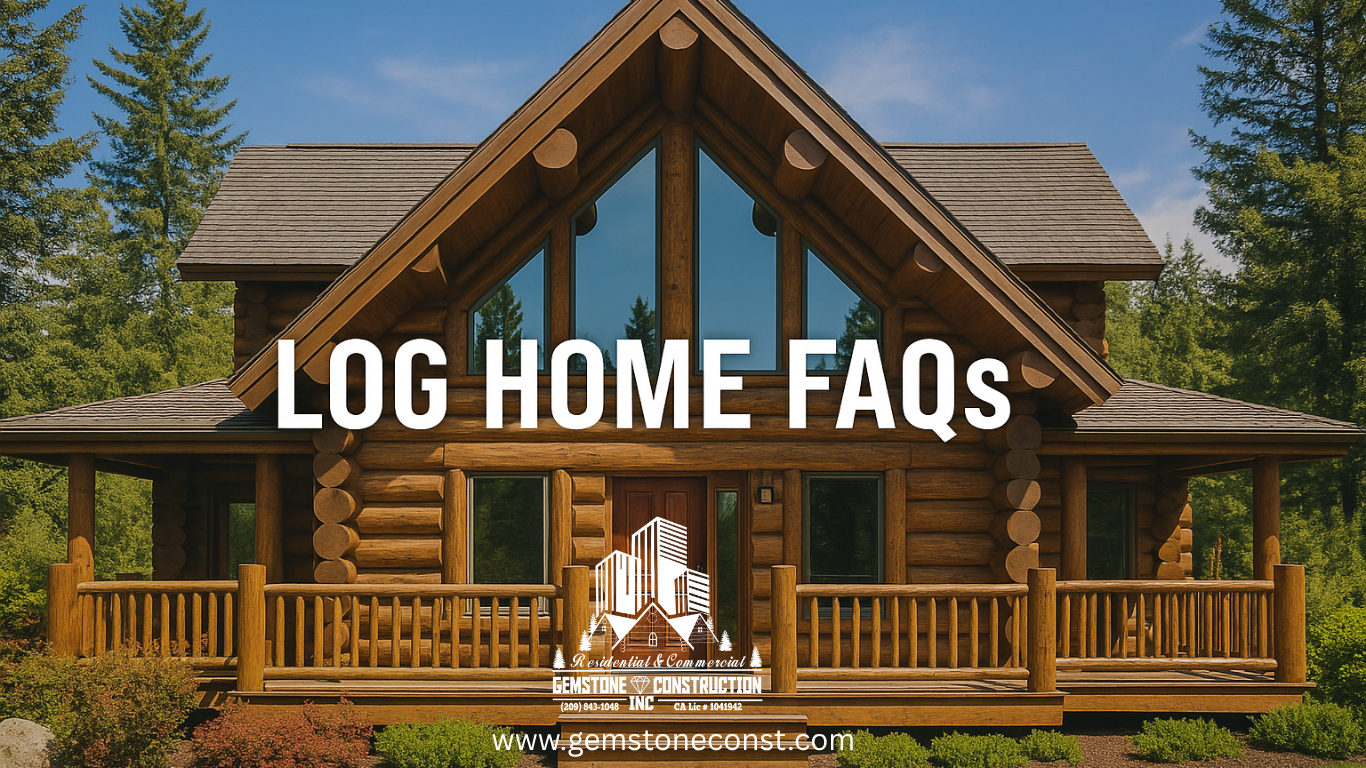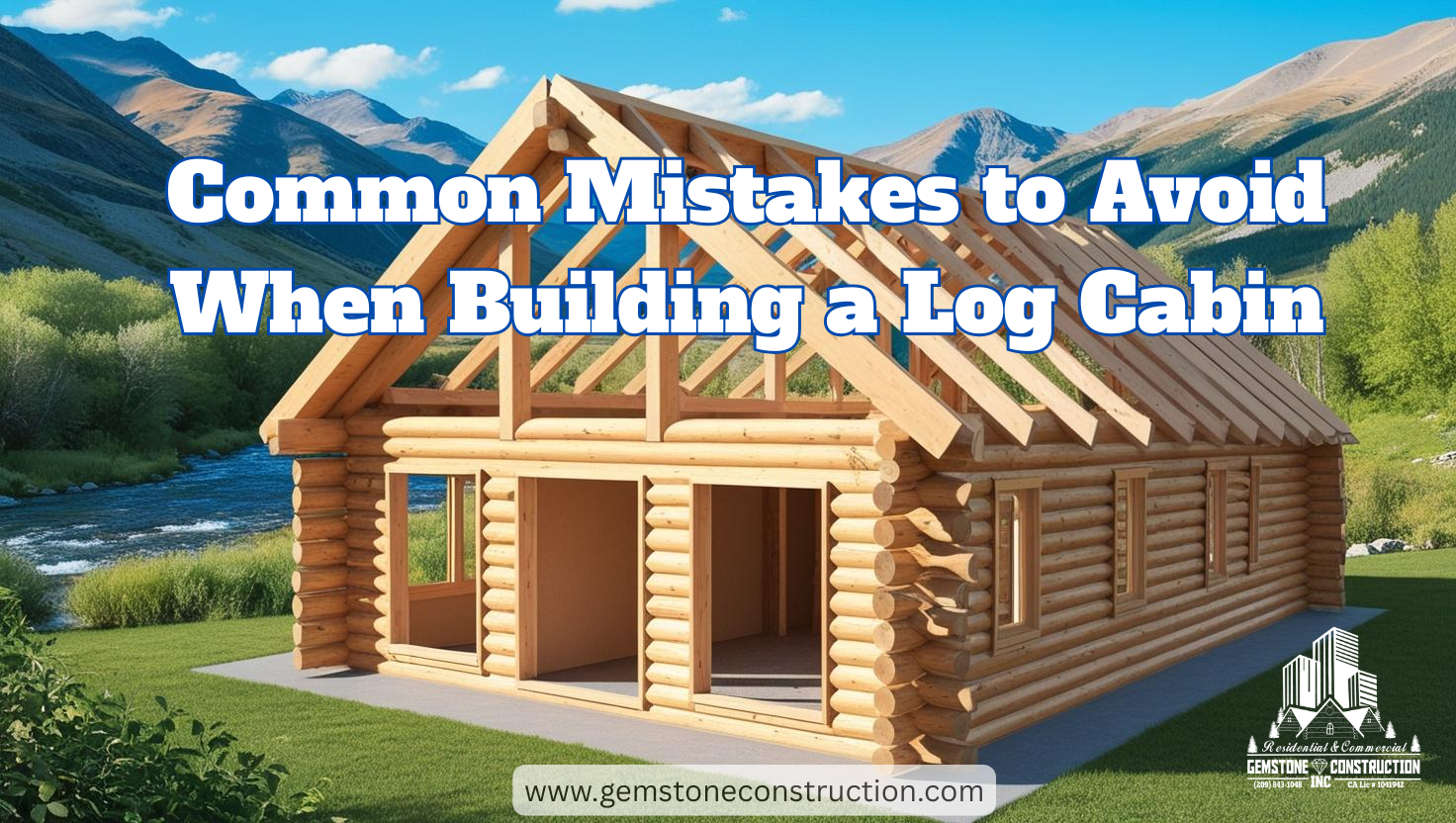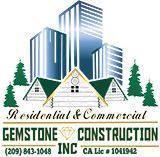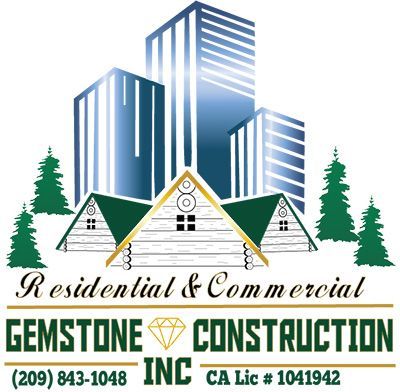GemStone Construction Blog
Site Selection Checklist for Your California Log Home
June 6, 2025 | Sacramento, CA USA
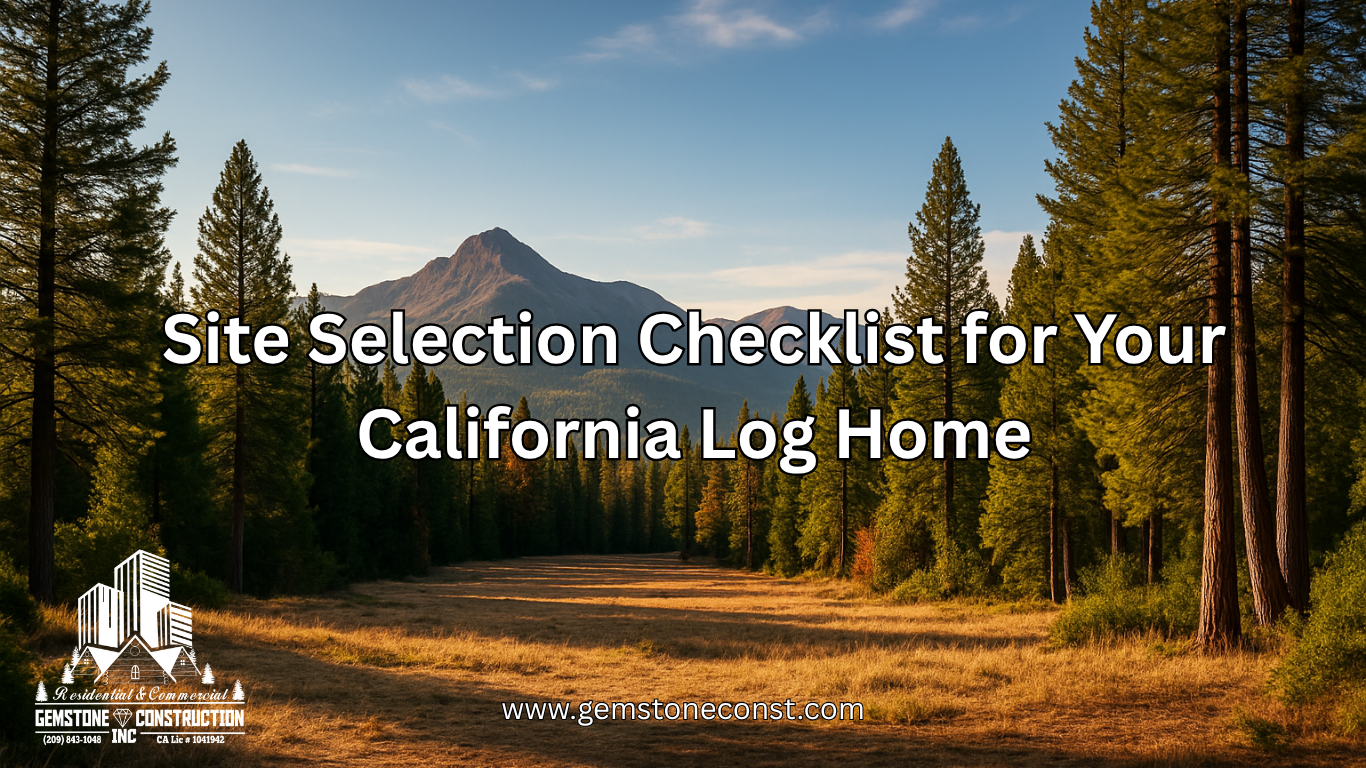
When it comes to building your dream log home in California, where you choose to build is just as important as what you build. Picking the right site sets the stage for everything else—design, budget, timeline, and your daily lifestyle. Whether you're dreaming of a cabin tucked away in the pines or a hillside view in wine country, log home site selection can make or break your project.
At Gemstone Construction, we specialize in helping families across California bring their log home dreams to life. With this checklist, we're sharing the real-world insights we’ve learned from years of building in the mountains, valleys, and everything in between.
What Makes a Good Log Home Site? Think About the Land Before the Logs
Not every beautiful plot of land is ideal for building. You’ll want to look beyond just the view. Ask yourself: Does the land slope? Are there access roads? Is there room for septic and well? These practical details can impact your timeline and your wallet. For example, a steep lot may need extra excavation or even a retaining wall. That adds cost and time. A flat lot, on the other hand, can mean quicker prep work and easier access for construction crews and delivery trucks. These are just some of the many things to also consider when it comes to factors that influence the total cost of building a log home.
Also consider the orientation of the lot. Southern-facing slopes in Northern California typically get more sun, which can be a major advantage in energy efficiency. Natural features like tree coverage, rock formations, or existing clearings can also help or hinder construction. Taking a full assessment of the land upfront can help avoid costly surprises later. You’ll also want to assess the wind patterns, how sunlight hits the property, and how much grading might be required. Even things like wildfire history or proximity to floodplains can completely change the viability of a location.
Look at Utilities and Access
Before you fall in love with a spot, check the basics. Is electricity available nearby, or will you need to go solar? Can you connect to city water, or will you need a well? Is internet available or do you need satellite? These details can affect your monthly costs and your quality of life. It’s not just about what’s there—it’s about what it’ll take to bring the property up to livable standards.
Also, think about how easy it is to get to your site. If you’re up a narrow, winding road that’s hard to access, it can delay deliveries and even make insurance more expensive. Accessibility isn't just about comfort—it's about cost. Emergency response time is another factor to consider, especially in fire-prone areas. Will fire trucks or ambulances be able to reach your site quickly if needed? A site that requires heavy road work or easement disputes can also significantly slow down your entire build.
Climate and Terrain: Know What You're Up Against
Weather Patterns Can Shift Everything
California’s terrain is wildly diverse. A cabin near Lake Tahoe will face snow and freezing temps. Down in the Central Valley, you’ll battle extreme summer heat. And coastal zones come with fog, salt air, and stricter codes. That means your site location heavily influences your home's needs for insulation, ventilation, and materials.
For snowy areas, you’ll need a steep roof pitch and materials that can handle ice. For hot areas, radiant barriers and upgraded insulation will reduce long-term cooling costs. And if you’re near wildfire-prone regions, you'll need to follow Cal Fire's building codes for defensible space and ignition-resistant construction. These extra steps now could save your home—and your budget—later. The more extreme your location's weather, the more critical it becomes to plan for long-term durability and comfort.
Test the Soil—Seriously
Before building, always get a soil test. This helps determine if your foundation will be stable. Clay-heavy soils, for instance, expand and contract with moisture and may need special footings. Rocky soils may require blasting, while sandy soils may need added reinforcement.
Bad soil doesn’t mean you can’t build—it just means you might have to spend more to do it right. Soil quality also affects things like drainage and erosion. A $500 soil test today can prevent $15,000 in foundation repairs later. Don't skip it. It’s one of the smartest investments you can make before breaking ground. Ask your builder or local county for soil testing labs or resources to start this step early.
Zoning, Permits & Building Codes
Don’t Assume—Check Everything
Just because there’s a cabin nearby doesn’t mean your land is ready to go. Zoning laws vary from county to county and even between townships. Your dream site might be zoned for agriculture or recreational use—not residential. Don’t assume anything—verify everything with your local building department.
You’ll want to ask the county about zoning, minimum square footage requirements, and whether manufactured or modular homes are allowed. Gemstone Construction can also help walk you through this step. We'll ensure you're not stuck with a parcel you can’t build on. It’s better to know upfront than to face expensive re-zoning delays or have your permits denied. Each county has its own quirks—be sure to read through their planning department's website for checklists and permit guides.
Know the Local Codes and Wildfire Rules
California has some of the strictest building codes in the U.S., especially when it comes to fire. In many areas, you’re required to follow Wildland-Urban Interface (WUI) codes. That means fire-resistant siding, tempered windows, Class A roofing, and a defensible zone around your cabin.
Skipping this step or not planning for it upfront can cause costly delays. For a deeper look, check out our Design & Planning page. This page walks you through code compliance and other key planning steps. Knowing the rules ahead of time helps us build smarter and faster. Compliance now helps avoid rejections later, especially during wildfire season.
Septic, Wells, and Drainage Considerations
Every Rural Build Needs a Septic Plan
If your dream lot is off the grid, you’ll probably need a septic system. The land has to pass a percolation ("perc") test to determine if it drains well enough for a septic tank. This test is done by a professional and approved by the county. You may also need room for a reserve leach field in case the original system ever fails.
Fail the test? You’ll either need to install an engineered system (more expensive) or find a new lot. Either way, it’s better to know before you buy. The cost of installing a septic system can range from $10,000 to $30,000 depending on soil type and topography. Planning this step early avoids major headaches and helps lock in your budget. Local public health departments usually have septic system guidelines and maps available to help you through this process.
Drainage Can Make or Break Your Cabin
Good drainage protects your cabin from future damage. Watch for signs like standing water, soggy soil, or natural slopes that drain toward the center of the property. Consider how rainwater flows during storms and where snowmelt might pool in spring.
Water should flow away from your future foundation. If it doesn’t, that can cause rot, mold, and expensive repairs down the road. We always recommend having a civil engineer or experienced contractor assess the drainage situation before finalizing your lot. Addressing these issues up front leads to a smoother build. Drainage plans should be incorporated early to ensure grading and slope support long-term structural health.
Future Plans & Lifestyle Fit
What Will Life Look Like 10 Years From Now?
Is this your forever home, a weekend getaway, or a short-term rental? The site you choose should reflect your long-term goals. If you want peace and quiet, make sure you're not near future development zones. If it's a rental property, think about proximity to attractions or towns.
Lifestyle fit isn’t just emotional—it’s strategic. Think about drive time to your job or grocery store. If you’re planning to retire there, consider medical access and year-round road conditions. Also consider whether you want off-grid capabilities like solar, well water, or a generator. A thoughtful site choice now saves regrets later. Talk to neighbors or local realtors about the direction the area is heading over the next decade.
Room to Grow (or Park the RV)
Don’t forget to plan for extras. Do you want a garage? A guest house someday? A big deck with a hot tub? Picking a site with a little breathing room now gives you flexibility later. Some counties have minimum setback requirements you’ll need to follow, so don’t plan to build right to the edge.
Also, make sure your chosen lot doesn’t have weird easements or utility lines running underground. These can limit how and where you can build later on. Pulling a full title report can reveal important legal restrictions before you buy. The more you plan now, the less you’ll have to redo later. Future-proofing your lot means more value and fewer headaches down the road.
FAQs: Log Home Site Selection
Can I build a log home on any type of land?
Not quite. The land must be zoned for residential use and must be able to pass tests for a well and septic system if it's off-grid. Some areas also require specific setbacks from roads, creeks, or property lines. It's best to check with the local planning department or have a builder like Gemstone Construction guide you through the process so you don’t make expensive mistakes.
How much does land preparation cost before building?
Costs vary, but on average, you can expect $15,000 to $50,000 in land prep for rural areas. This includes clearing trees, grading, soil testing, and setting up utilities. Steep slopes or poor soil can raise the price significantly, so a professional site review is highly recommended before you buy. It’s a smart investment to avoid budget overruns later.
What’s the most common mistake buyers make with site selection?
One of the biggest mistakes is falling in love with the view and ignoring the practical stuff—like access to utilities, soil quality, or zoning restrictions. It’s also common to underestimate how local climate and terrain can affect your build and your comfort living there long-term. Partnering with an experienced builder like Gemstone can help you avoid these common pitfalls from day one.
Final Thoughts: Let’s Build Your Dream
At Gemstone Construction, we know that great homes start with smart planning. Log home site selection isn’t the most glamorous part of building your log home—but it’s the most important first step.
Our team is here to guide you through every decision so that you don’t end up with surprise costs or delays. If you’re not sure where to start, schedule a consultation and we’ll help evaluate your top property choices.
We’re not just building cabins—we’re building your dreams.
About Gemstone Construction
Gemstone Construction is a premier custom home and commercial building contractor serving Northern California, including the Sacramento area. Specializing in
custom log homes,
luxury home builds,
residential metal building construction, commercial construction and
commercial metal building construction. We bring craftsmanship, attention to detail, and personalized service to every project. From designing dream homes to building cutting-edge commercial spaces, our dedicated team ensures that each build reflects our clients' unique vision and exceeds expectations. Trust Gemstone Construction to transform your ideas into reality with integrity and excellence.
Learn more about Gemstone Construction
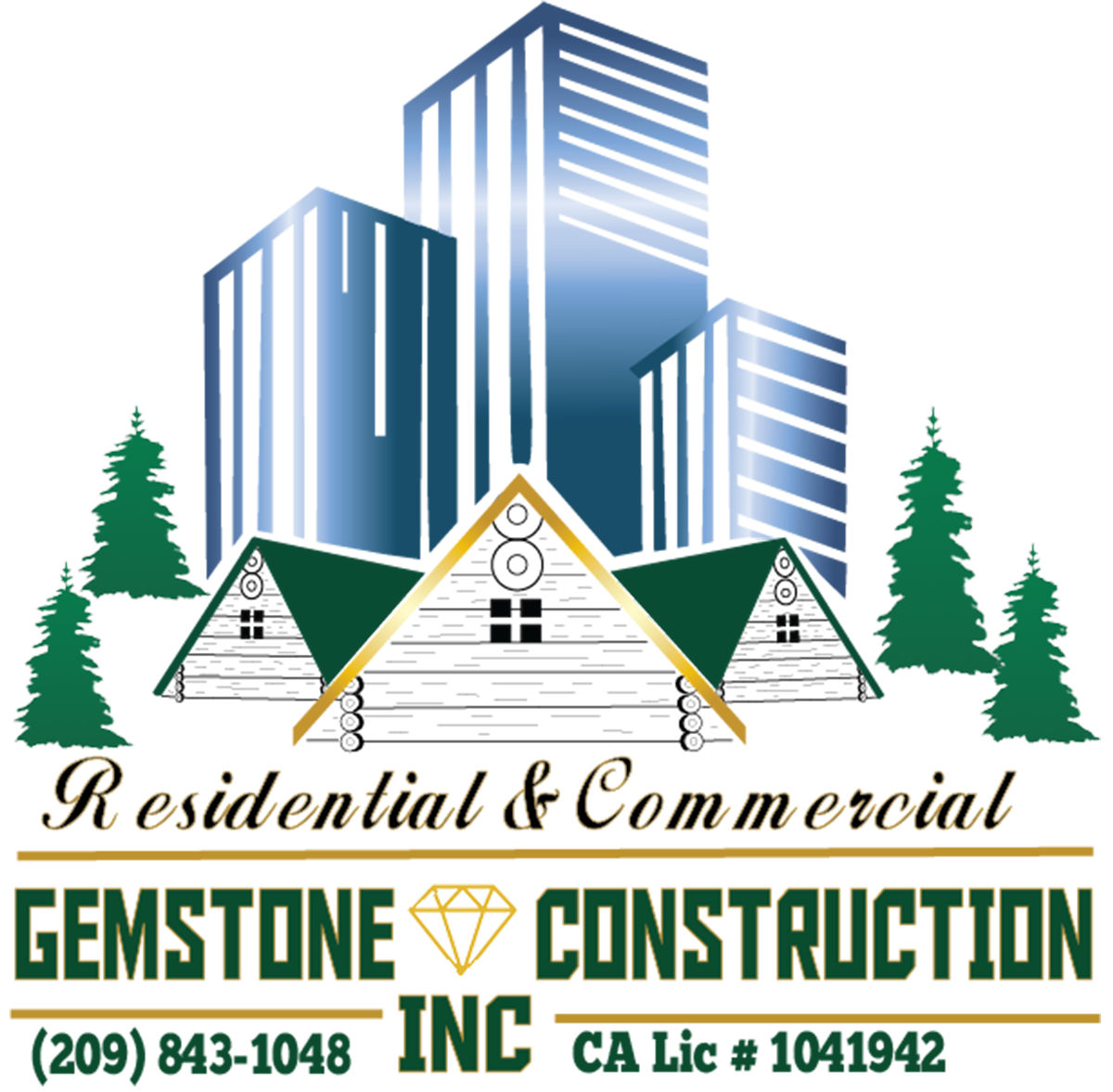
Contact Information

